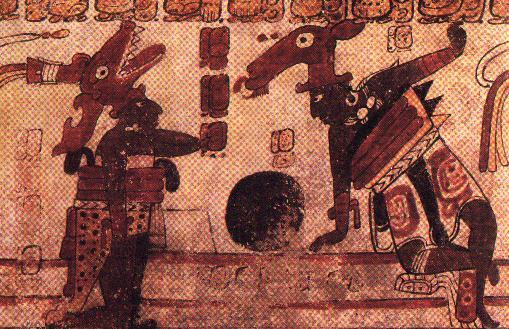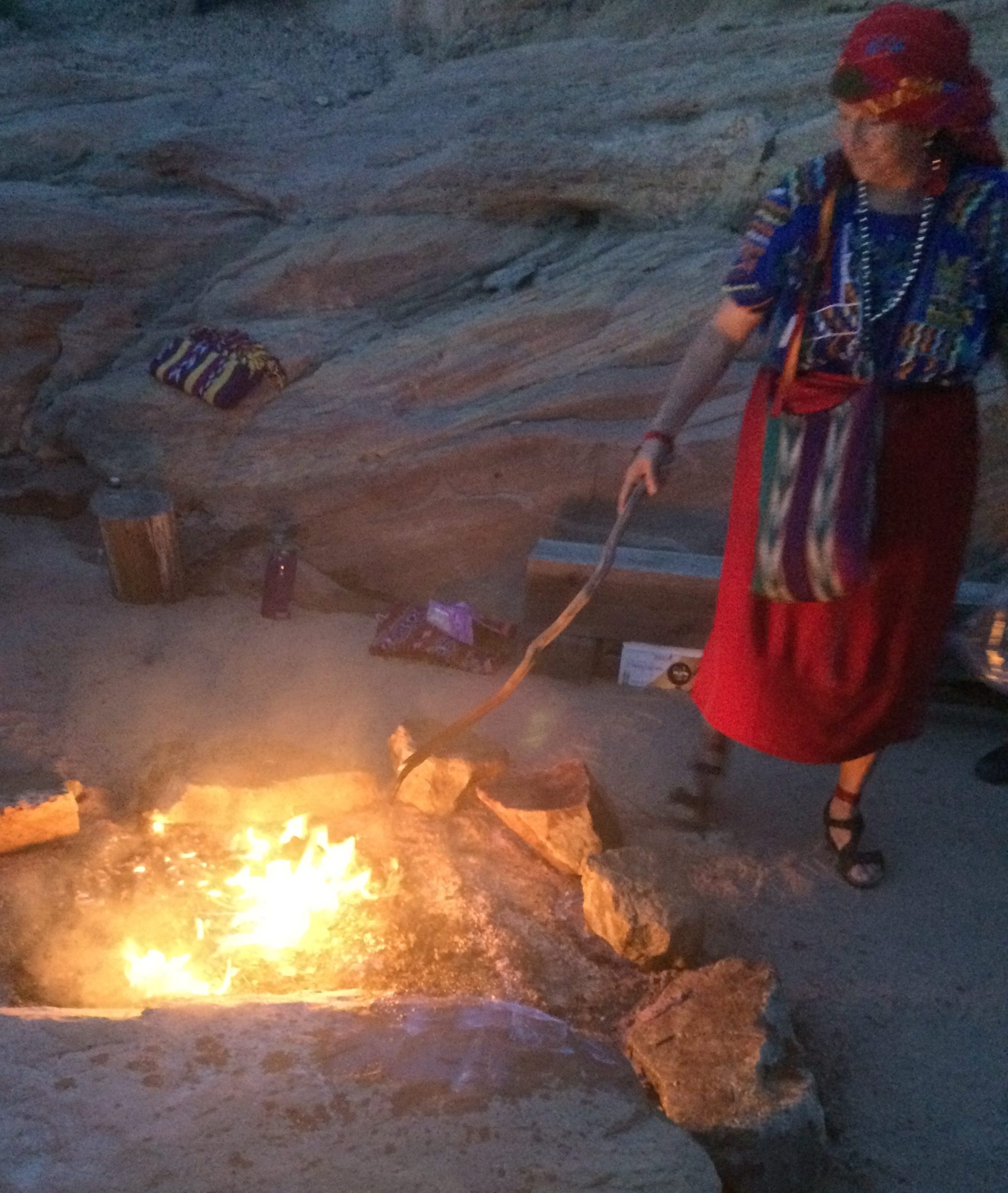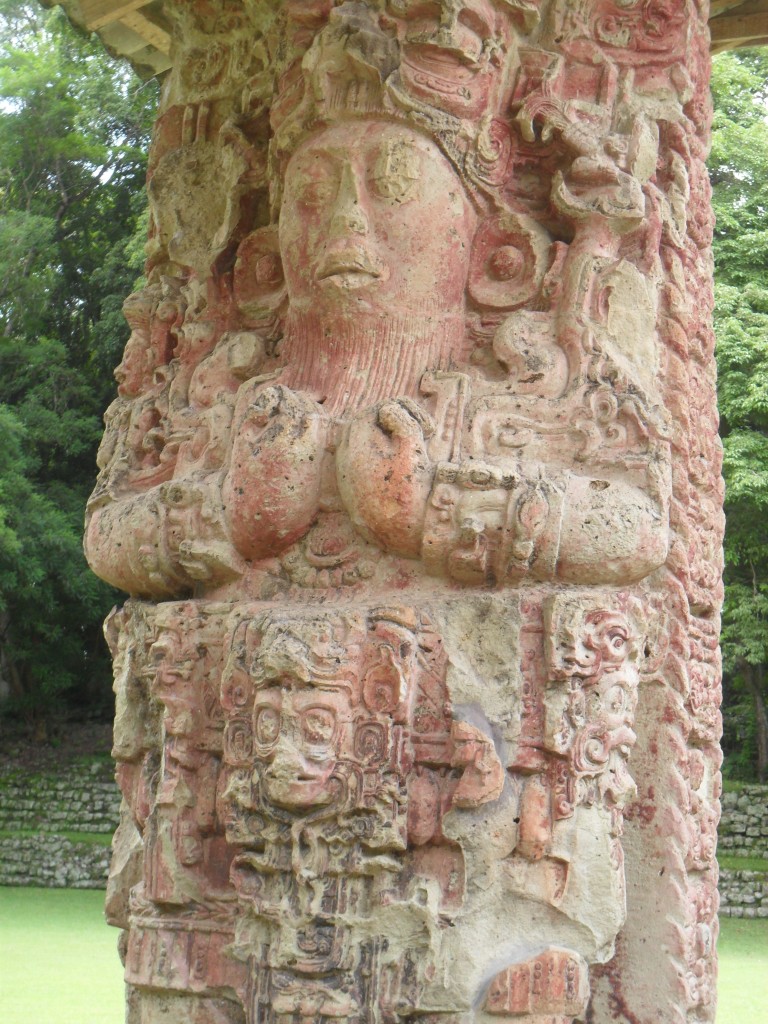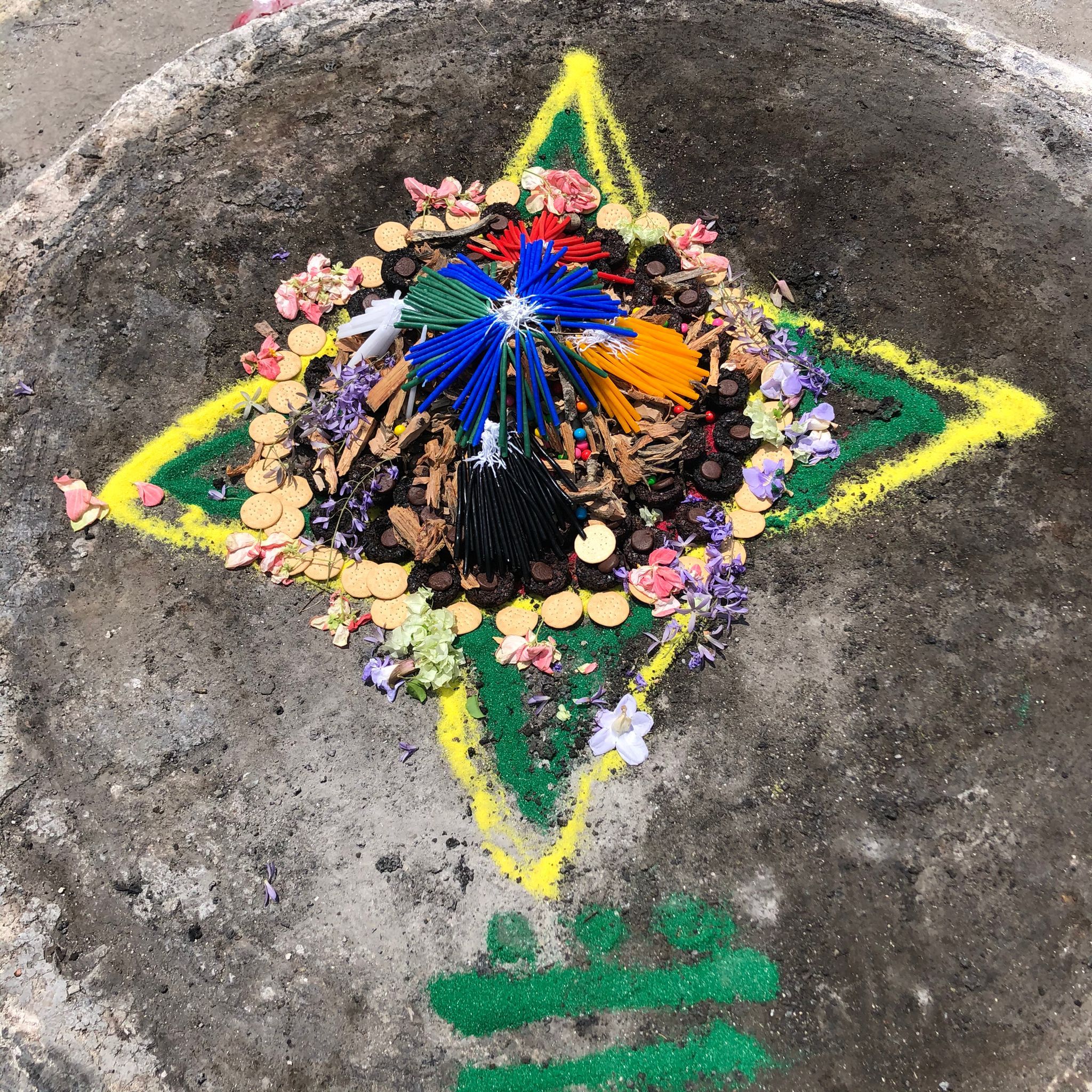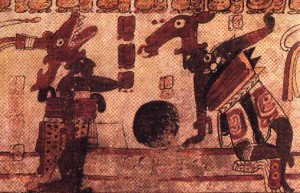 Maya guide, educator and researcher Lina Barrios describes the continued relevance of the Maya Cosmovision in today’s modern world. The Cosmovision has withstood untold challenges, yet remains essential in the lives and flourishing of Maya identity and holds keys for potentially improving all our lives and even transforming modern civilization.
Maya guide, educator and researcher Lina Barrios describes the continued relevance of the Maya Cosmovision in today’s modern world. The Cosmovision has withstood untold challenges, yet remains essential in the lives and flourishing of Maya identity and holds keys for potentially improving all our lives and even transforming modern civilization.
All posts by Lina Barrios
Interview w/ Lina Barrios
 We were sad to see Lina and Denise leave New Mexico this morning, but we are grateful for all of the wisdom and experience they shared during there time here. This includes giving an interview for the Future Primitive podcast. This is a great interview, covering numerous topics including Lina’s award winning work in supporting women and Indigenous Maya, the importance of the Popol Wuj, the Maya significance of 2012 and more. Thank you again to Joanna and Jose for conducting and editing such a great interview! Check it out:
We were sad to see Lina and Denise leave New Mexico this morning, but we are grateful for all of the wisdom and experience they shared during there time here. This includes giving an interview for the Future Primitive podcast. This is a great interview, covering numerous topics including Lina’s award winning work in supporting women and Indigenous Maya, the importance of the Popol Wuj, the Maya significance of 2012 and more. Thank you again to Joanna and Jose for conducting and editing such a great interview! Check it out:
The Strength of Mayan Culture – Future Primitive Podcasts
Cholab’ (Ab’) New Year
 All great civilizations of the world have developed their own form of counting time, their calendar. Maya civilization developed several different calendars, which they accomplished through their outstanding knowledge in astronomy and mathematics. It is thought they developed thirteen calendars, however only seven have been discovered, with three of them still being in use by the Maya people:
All great civilizations of the world have developed their own form of counting time, their calendar. Maya civilization developed several different calendars, which they accomplished through their outstanding knowledge in astronomy and mathematics. It is thought they developed thirteen calendars, however only seven have been discovered, with three of them still being in use by the Maya people:The Cholq’ij, a 260 day calendar still being used in the highlands of Guatemala by practitioners of Maya spirituality. This calendar is mentioned in the Popol Wuj, Memorial de Sololá and Rabinal Achí.
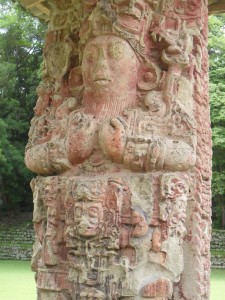 The 365 days of the Cholab’ are divided into 18 periods of 20 days each. The number 20 arises from the cosmic and telluric energies of the fingers on the hands and toes on the feet. There are the 360 days (18×20), plus a 5 day period known as the Wayeb. This last period of five days is known in the west as the unlucky or lost days, but in the traditional Maya world view it is a time for introspection and gratitude to the Ajaw (Creator and Former of life). It is a space and time dedicated to cleanse ourselves in the four levels: intellectual, spiritual, emotional and physical. It is a time to review our actions – every positive and negative thing we have done for the last 18 months and the impact it has had in our lives. It is a time to accept the things that have happened to us, accept our mistakes and understand that everything is part of our growth and evolution. It is a moment to ask for the forgiveness of the people we have hurt during the year.
The 365 days of the Cholab’ are divided into 18 periods of 20 days each. The number 20 arises from the cosmic and telluric energies of the fingers on the hands and toes on the feet. There are the 360 days (18×20), plus a 5 day period known as the Wayeb. This last period of five days is known in the west as the unlucky or lost days, but in the traditional Maya world view it is a time for introspection and gratitude to the Ajaw (Creator and Former of life). It is a space and time dedicated to cleanse ourselves in the four levels: intellectual, spiritual, emotional and physical. It is a time to review our actions – every positive and negative thing we have done for the last 18 months and the impact it has had in our lives. It is a time to accept the things that have happened to us, accept our mistakes and understand that everything is part of our growth and evolution. It is a moment to ask for the forgiveness of the people we have hurt during the year.The Tz’ite’
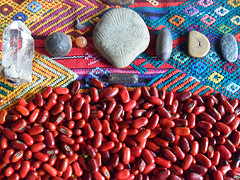 B’alam was pretty excited to go with his grandfather to the mountain. They left very early in the morning, to the Sacred Mountain of Alux, to pick some Tz’ite’. These are the red beans used to communicate with Chuchqajaw (Mother and Father of the Universe). B’alam went to bed early so that he would wakeup as soon as his grandfather called him.
B’alam was pretty excited to go with his grandfather to the mountain. They left very early in the morning, to the Sacred Mountain of Alux, to pick some Tz’ite’. These are the red beans used to communicate with Chuchqajaw (Mother and Father of the Universe). B’alam went to bed early so that he would wakeup as soon as his grandfather called him.
“B’alam, B’alam,” his grandfather’s soft voice called still in the darkness of the early hours.
“Coming grandpa,” B’alam answered.
He dressed quickly and went with his grandfather to the family altar to ask for permission and blessings for the day’s activities. Tthey asked specially to find many Tz’ite’ seeds.
Grandfather and grandchild were walking along a path filled with fog of the Sacred Mountain of Alux. They were tukos, meaning they shared the same name, B’alam. For this reason the elder taught him with much love and dedication, for he will be his successor upon this earth. He told his grandson, “remember the Tz’ite’ should always be picked up with the first rays of the Sun, so that the communication with the energies will flow.” They continued climbing for a while. When they reached a clearing, the first Tz’ite’ tree appeared. The pods were open with plenty of red seeds coloring the brown ground. They both kneeled and thanked Chuchqajaw for the beans had ripen and could be picked.
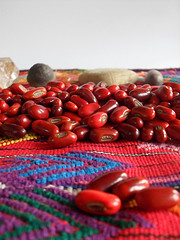 “Son, the Tz’ite’ beans are picked with a lot of respect.” B’alam looked up and his wide black eyes lit with intrigue when he asked the elder: “Why grandpa?” “Because they are sacred,” the grandfather answered with a tranquility that comes with his years, “and before you touch sacred things you blow the palms of your hands, to clean them so that your energy will not take away the strength of the sacred.” “What do you mean?” B’alam asks with more curiosity. “If the beans are on the ground they are dirty, why should I clean my hands before touching them?” “The beans are not dirty, they fell from the tree and are absorbing strength from Mother Earth, for us to communicate with the energy of Uk’u’x Ulew (Heart of the Earth)” “So through the beans we can only communicate with the energy of earth?”
“Son, the Tz’ite’ beans are picked with a lot of respect.” B’alam looked up and his wide black eyes lit with intrigue when he asked the elder: “Why grandpa?” “Because they are sacred,” the grandfather answered with a tranquility that comes with his years, “and before you touch sacred things you blow the palms of your hands, to clean them so that your energy will not take away the strength of the sacred.” “What do you mean?” B’alam asks with more curiosity. “If the beans are on the ground they are dirty, why should I clean my hands before touching them?” “The beans are not dirty, they fell from the tree and are absorbing strength from Mother Earth, for us to communicate with the energy of Uk’u’x Ulew (Heart of the Earth)” “So through the beans we can only communicate with the energy of earth?”
“Of course not, the sacred red beans are very sensitive and they can communicate us with the Uk’u’x Kaj (Heart of the Heavens), Uk’u’x ja’ (Heart of Water), Uk’u’x I’q (Heart of the Air). Because of this, their energy can see events that happen faraway and nearby, great events and small events. They can see the past and the future. The sensitivity of the red beans was discovered by the two times grandfather Ixpiyakok and the two times grandmother Ixmukane, and they left this inheritance to us. Remember, we eat black beans every day and sometimes we eat white and brown beans, but we never eat the red beans for they are sacred. The Tz’ite’ is the means of communication with all the creation energies. They answer all doubts to give you clarity on your path, and tell you what is favorable and what is not, for this it is sacred. But remember B’alam’ only the Ajq’ijab (spiritual guides) can ask to the Tz’ite’, for it has its secrets and if its energy is not used appropriately, it can harm you. It’s like giving a knife to a two year old. First one has to learn how to use it.”
This is the fourth in a series of short stories written by Mayan Ajq’ij (spiritual guide) Lina Barrios from Guatemala. These stories are meant to share the knowledge and wisdom of the Mayan peoples with the world.
The Wayeb
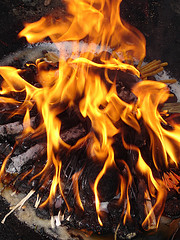 For 5,000 years the Maya have simultaneously used 20 different calendars for various purposes: agricultural, sacred, and predictions, amongst others.
For 5,000 years the Maya have simultaneously used 20 different calendars for various purposes: agricultural, sacred, and predictions, amongst others.
The Hab’ is one of these Maya calendars. It has 18 months of 20 days each, plus a small month of 5 days, totaling 365 days. The Hab’ is the most accurate calendar of the ancient world. According to the most sophisticated computers, the length of a year is 365.2422 days and the calculations of the Maya are at 365.2420 days.
One of the most relevant things about the Hab’ are the 5 days prior to the New Year. This time is used to purify several aspects of one’s self, in order to receive the coming year with good energy. During these days people clean their homes, giving away the things that are no longer useful to them but might be useful to someone else. They paint their house, fast to eliminate accumulated toxins, and meditate and reflect on the offenses they have done to others, for which they apologize. They bathe in thermal springs or saunas to purify their bodies, practice sexual abstinence, and reflect upon whether or not they have fulfilled their goals – and why or why not. They doing a cleansing and seeking for balance in the four levels:
- Material: by cleaning their body and their home
- Spiritual: by cleaning their spirit
- Emotional: by cleaning envies and bad feelings in their heart
- Intellectual: by cleaning the bad thoughts of their mind
The goal is to find an understanding of why we did not accomplish certain purposes so as to not commit the same mistakes in the coming year.
For this reason this 5 day month receives the name of Wayeb’ in Yucatec Maya and Tz’apil in K’iche’ Maya. The latter one means closing a door, for it is closing the door to the old year and receiving the new one cleansed in all levels to achieve happiness.
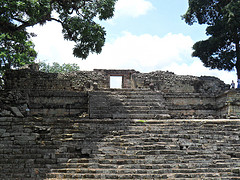 On the first day of the year, people wear new clothes, with new energy to start the year without the burden of the previous one. They also light a new fire, as the old fire was put out at the beginning of the Wayeb’. During these five, days the fire, the comal (clay or metal dish used to make tortillas), the pot used to cook maize and the grinding stone rest – until a new fire is lit at the start of the new year.
On the first day of the year, people wear new clothes, with new energy to start the year without the burden of the previous one. They also light a new fire, as the old fire was put out at the beginning of the Wayeb’. During these five, days the fire, the comal (clay or metal dish used to make tortillas), the pot used to cook maize and the grinding stone rest – until a new fire is lit at the start of the new year.
The whole community is in a profound cleansing process to have a good beginning to the coming year. We will start the year, 5,200, on February 22, 2012. This day is also Oxlajuj (13) N’oj, which brings an energy of development, awareness, knowledge and wisdom to the year. It is a good year to learn from your experiences, acquire knowledge in all levels and increase your spiritual development.
If each year we cleanse ourselves, our path becomes easier, without many burdens. Our baggage becomes lighter, our health becomes better, we will be happier, more understanding, our life will flow easier into the universe, things will be solved faster. If we climb a mountain carrying a 50 pound bag it will be tough climb, but if we are carrying a 10 pound backpack we will walk faster, without getting that tired. We will enjoy the view, breathe the air, we will not need to rest too often and we will reach the peek faster to enjoy the beautiful view from the top. This is the difference we make in our life if we cleanse ourselves every year. The funny thing is that we service our car when we have driven it for a number amount of miles, assuring it will last longer and be in better condition, but we don’t service ourselves. The Wayeb’ or Tz’apil is the service that the Maya people make, not to cars – to themselves.
This is the third in a series of short stories written by Mayan Ajq’ij (spiritual guide) Lina Barrios from Guatemala. These stories are meant to share the knowledge and wisdom of the Mayan peoples with the world. This story relates to the 5 day month known as the Wayeb, which occurs from 2/17 through 2/21 2012 on the Gregorian Calendar.
2012
 Ixkotzij (flower woman) and her sister went with their mother to visit their grandfather, Kawoq. They visited him every 13 days, since he lived far away. The two sisters were very excited to see him. He was often smiling, as he liked to tease them, and he always answered all the questions the girls asked, even the most difficult ones. From moment they left the house, Ixkotzij began thinking of a difficult question to ask her grandfather. He taught them no to be content with an “I don’t know, just because, who knows”; or that type of answer. He said everything had a reason and they were entitled to know it.
Ixkotzij (flower woman) and her sister went with their mother to visit their grandfather, Kawoq. They visited him every 13 days, since he lived far away. The two sisters were very excited to see him. He was often smiling, as he liked to tease them, and he always answered all the questions the girls asked, even the most difficult ones. From moment they left the house, Ixkotzij began thinking of a difficult question to ask her grandfather. He taught them no to be content with an “I don’t know, just because, who knows”; or that type of answer. He said everything had a reason and they were entitled to know it.
Grandfather Kawoq had gray hair, which he was starting to lose. When you came into his house you could listen to an old radio playing marimba music. While Ixkotzij’s mother and sister where preparing food in the kitchen, she asked her grandfather the question she had planned for this visit. “Grandpa, why are people in the city saying that the world will end in 2012? What are all those Maya prophecies about? And how come you never told me anything about it? I think that is not fair, you never warned us.”
Grandfather Kawoq smiled and told her in a pleasant voice: “Our ancestors, the grandfathers and grandmothers, have never said the world is going to end. That’s why I didn’t say anything to you. Our grandfathers and grandmothers have taught us to take care of Mother Earth, to not destroy her. So the world is not going to end. Hasn’t your mother taught you not to waste water, to use just the wood that you need? Hasn’t you father taught your brother to cut the wood on a full moon so that it will last for many years, and to use the branches of old trees? Don’t you remember that as a child you helped pick up the branches from the woods so that we did not have to cut many trees? Our grandfathers and grandmothers have taught us these and many other things. They taught us to love Mother Earth, to ask her permission before we take anything from her, but they have never taught us that the world is going to end. I think that the people who are saying the world will end are saying so because they know deep inside that they are destroying Mother Earth, and they feel bad about it.”;

Grandfather Kawoq stood silently, meditating for a while, then he continued:
“In the big cities everything works with electric power – even the stairs work with electric power. They use it for the elevators, to carry their water, to wash and dry their clothes, and to cook their food. They use it for everything. What would happen if they no longer had electric power? There are many things they won’t be able to do. But what happens to us? Not much. If there is no electric power, our world continues to be the same. Our houses, at most, have two stories – not 40, 60 or 90 like the buildings in big cities. We bring our water from the river in pitchers. We hand wash our clothes. We enjoy drying them with the energy of Father Sun, because his energy and strength is imprinted on our clothes. We pick wood from the forest to cook our food and keep our house warm. But in big cities, if they don’t have electric power, their world somehow ends, because they are fragile. They don’t live in harmony with Mother Earth. Unlike us, they live away from her. Everything in their world is artificial. Their world depends on electricity, on fuel, on a car. We live in contact with nature. We take care of Mother Earth in the same way she takes care of us. Our world will not end, so don’t worry my beloved Ixkotzij.”
This is the second in a series of short stories written by Mayan Ajq’ij (spiritual guide) Lina Barrios from Guatemala. These stories are meant to share the knowledge and wisdom of the Mayan peoples with the world.
The Perfect Complement
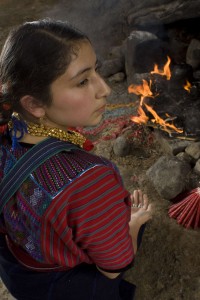 In order to keep the long-standing tradition, Ixkab’ (woman of honey) finishes the third and final cloth used to make a huipil (blouse) for her youngest daughter. Her heart is joyful, she has woven all the necessary cloths to make her husband’s, daughter’s and her own clothing. Early in the morning she will give her beloved husband all the cloths so he can begin putting them together to maintain the complement of energies. He will sit in their house, at the corridor, for 20 days with a basket full of threads to sew the huipiles, cortes (skirts), trousers and shirts, and he will have them ready before theHab’ (the New Year) so that the whole family will wear new clothes.
In order to keep the long-standing tradition, Ixkab’ (woman of honey) finishes the third and final cloth used to make a huipil (blouse) for her youngest daughter. Her heart is joyful, she has woven all the necessary cloths to make her husband’s, daughter’s and her own clothing. Early in the morning she will give her beloved husband all the cloths so he can begin putting them together to maintain the complement of energies. He will sit in their house, at the corridor, for 20 days with a basket full of threads to sew the huipiles, cortes (skirts), trousers and shirts, and he will have them ready before theHab’ (the New Year) so that the whole family will wear new clothes.
He has enough time, as it is still 25 days to the Hab’. He will sew for 20 days, until the start of the month prior to the New Year, known as the Tz’apil. The Tz’apil is a month of only five days, which are used for purification in order to begin the New Year with a clean body, spirit, heart and mind – as well as with new clothes.
Ixkab’ thought of how sad it was when those machines came to town… “What are they called?… Singer?… What is the meaning of that name? It is not a Maya name, who knows in what language it is, these machines come from elsewhere. These machines are breaking with the tradition of our people. How is it possible that men, instead of sitting in the corridor, are paying a stranger to put together their clothes in these machines?” They say the machines sew better than the hands of the men, but Ixkab’ thought her husband did a better job, for he did it with love, just as she did when she wove the cloths. “Our daughter will feel that love, the love we have for her, my husband will feel the love I have for him… How can a metal, a cold metal give love to people? Surely people were wrong, our grandmothers taught us to weave joyfully and to imprint love to the cloths, our grandfathers taught the men to sew the cloths together with strength and love…”
“We must continue this complementing, as we were taught from the time of Creation, when Tz’aqol the former of matter and B’itol the giver of breath, when Alom the female energy and K’ajolom the male energy, when Tepew, who is stability and Q’uq’kumatz who is movement, when Uk’u’x Kaj who is the heavens and Uk’u’x Ulew who is earth, when Uk’u’x Palow who is salt water and Uk’u’x Cho who is fresh water, when Grandmother Ixmukane and Grandfather Ixpiyako’k created human beings with the nine beverages of maize. They taught us the importance of this complementing in order to have balance, to find peace.” Ixkab’s thoughts continued thinking of all the energies of creation and she concluded that women alone could not do the family’s clothing, both man and woman had to work together to complement each other. It is similar to having children, she thought, a woman alone cannot have children, a man alone cannot have children; love, harmony and complementing are necessary.
This short story is a reflection of the complementing of Maya men and women, values that have been with them since the time of Creation, together with the respect they have for Mother Earth, the solidarity and community service, all of which are the pillars of Maya wisdom.
This is the first in a series of short stories written by Mayan Ajq’ij (spiritual guide) Lina Barrios from Guatemala. These stories are meant to share the knowledge and wisdom of the Mayan peoples with the world.

